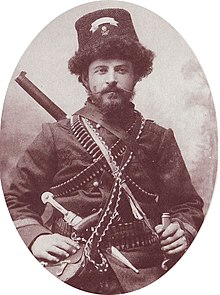This is an old revision of this page, as edited by Smasongarrison (talk | contribs) at 02:57, 24 December 2024 (Moving from Category:Prisoners and detainees of the Ottoman Empire to Category:Foreign nationals imprisoned in the Ottoman Empire Diffusing per WP:DIFFUSE and/or WP:ALLINCLUDED using Cat-a-lot). The present address (URL) is a permanent link to this revision, which may differ significantly from the current revision.
Revision as of 02:57, 24 December 2024 by Smasongarrison (talk | contribs) (Moving from Category:Prisoners and detainees of the Ottoman Empire to Category:Foreign nationals imprisoned in the Ottoman Empire Diffusing per WP:DIFFUSE and/or WP:ALLINCLUDED using Cat-a-lot)(diff) ← Previous revision | Latest revision (diff) | Newer revision → (diff) Aromanian revolutionary in Ottoman Macedonia
| Voivode Pitu Guli | |
|---|---|
 Pitu Guli in guerilla attire Pitu Guli in guerilla attire | |
| Nickname(s) | Pitu the Vlach |
| Born | c. 1865 Kruševo, Ottoman Empire |
| Died | 12 August 1903(1903-08-12) (aged 37–38) Kruševo Republic |
| Allegiance | |
| Years of service | 1885–1903 |
| Battles / wars | |
Pitu Guli (Cyrillic: Питу Гули; 1865–1903) was an Aromanian revolutionary in Ottoman Macedonia, a local leader of what is commonly referred to as the Internal Macedonian Revolutionary Organization (IMRO).
Life
He was born to a poor family in Kruševo (Aromanian: Crushuva) in the Ottoman Empire (now North Macedonia). Guli demonstrated an independent and rebellious nature early in life. He left his home in Macedonia at the age of 17 in search of wealth in the Bulgarian capital, Sofia. In 1885, he returned to Macedonia, as part of a rebel squad of the revolutionary movement against the Ottoman Empire, led by Adam Kalmikov. He was captured and exiled to eastern Anatolia for a period of eight years, seven years of which were spent in the prison in Trabzon. In 1895, he again returned to Kruševo and became a member of IMARO. From this time on, he was fully committed to the autonomy of Macedonia from Turkish rule. Between 1897 and 1902 he was again in Sofia, where he also held an eating house.

In March 1903, he began commanding a revolutionary squad, crossing the Bulgarian-Ottoman border heading for Kruševo. From April to August 1903, he trained and prepared his irregulars for the upcoming Ilinden Uprising. He died in Kruševo, defending the Kruševo Republic.
Family
Except for Bulgarian Exarchist Aromanians, as Guli's family, who were Bulgarophiles, most members of other ethnicities dismissed the IMRO as pro-Bulgarian. His sons were:
- Tashko Gulev (Shula Guli), a soldier of the Bulgarian Army who died in 1913 in the battle of Bregalnica against the Serbs, during the Second Balkan War.
- Nikola Gulev (Lakia Guli), IMRO revolutionary and one of the people closest to Todor Alexandrov. He was arrested by the police of Kingdom of Serbs, Croats and Slovenes and died in custody after being tortured in 1924.
- Steryo Gulev (Sterya Guli), who took part in the military units formed by former IMRO activists in Vardar Macedonia during the Bulgarian occupation in World War II, to fight the communist Yugoslav Partisans. He reportedly shot himself after Bulgaria switched sides and withdrew from Yugoslavia in 1944, upon the arrival of Tito's partisans in Kruševo, in despair over what he saw as a second period of Serbian dominance in Macedonia.
Legacy
Pitu Guli is a national hero in North Macedonia and Bulgaria, and remembered as having fought heroically at Mečkin Kamen (Bear's Rock) near Kruševo, where he was killed during the Ilinden Uprising in defense of the Macedonian Kruševo Republic. A Macedonian Partisan Brigade was named after him. The Macedonian partisan Kuzman Josifovski took the alias "Pitu" after him. He is also celebrated in folk songs and poetry throughout the region of Macedonia, being mentioned in the national anthem of North Macedonia ("Denes nad Makedonija", "Today over Macedonia"). An Aromanian-language song about him, Cãnticlu al Pitu Guli ("The Song of Pitu Guli"), has also been composed.
Notes
- Alternative spellings of his name are Pito (Пито) and Gule (Гуле) or Gulev (Гулев).
- His name is alternatively spelled in the older Bulgarian orthography as Пито Гулевъ.
References
- ^ Brown, K. (2003) The Past in Question: Modern Macedonia and the Uncertainties of Nation (Princeton: Princeton University Press); pp. 196–198, ISBN 0-691-09995-2
- Aromanian consciousness was not developed until the late 19th century, and was influenced by the rise of Romanian national movement. As result, wealthy, urbanized Ottoman Vlachs were culturally hellenised during 17-19th century and some of them bulgarized during the late 19th and early 20th. century. Raymond Detrez, 2014, Historical Dictionary of Bulgaria, Rowman & Littlefield, ISBN 1442241802, p. 520.
- Коста Църнушанов, Македонизмът и съпротивата на Македония срещу него, Университетско изд. "Св. Климент Охридски", София, 1992, стр. 132.
- Тодор Балкански, Даниела Андрей, Големите власи сред българите, Знак 94, ISBN 9548709082, 1996, стр. 60-70.
- Thede Kahl, Istoria aromânilor, Biblioteca de istorie, Colecția Sens; Tritonic, 2006, ISBN 9737330412, p. 123.
- Andrew Rossos, Macedonia and the Macedonians: A History, Hoover Press, 2013, ISBN 081794883X, p. 105.
- Philip Jowett, Armies of the Balkan Wars 1912–13: The priming charge for the Great War, Bloomsbury Publishing, 2012, ISBN 184908419X, p. 21.
- Македоно-одринското опълчение 1912-1913 г. Личен състав, Главно управление на архивите, 2006, стр. 190.
- Македонска енциклопедија, МАНУ, Скопје, 2009, стр. 415-416.
- Historical Dictionary of the Republic of Macedonia, Dimitar Bechev, Scarecrow Press, 2009, ISBN 0810862956, p. 91.
- Roumen Dontchev Daskalov; Diana Mishkova, Entangled Histories of the Balkans - Volume Two: Transfers of Political Ideologies and Institutions (2013), Balkan Studies Library, BRILL, ISBN 9004261915, p. 536.
- Pål Kolstø, Strategies of Symbolic Nation-building in South Eastern Europe, Routledge, 2016, ISBN 1317049365, p. 188.
- Grigore, George V. (6 March 2018). "Imnul de stat al Macedoniei cântă vitejia unui erou român: Pitu Guli, zis și Pitu Vlahul". Ziarul Națiunea (in Romanian).
- Stăncioiu, Octavian (11 September 2017). "Pero Tsatsa și Armânamea la Seara makiduneascâ din Dudeștii Noi". Banatul Azi (in Romanian).